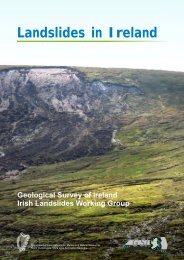Achill - Geological Survey of Ireland
Achill - Geological Survey of Ireland
Achill - Geological Survey of Ireland
Create successful ePaper yourself
Turn your PDF publications into a flip-book with our unique Google optimized e-Paper software.
1 st Draft <strong>Achill</strong> GWB Description July .2004Topography<strong>Achill</strong> GWB: Summary <strong>of</strong> Initial Characterisation.Hydrometric AreaLocal Authority33MayoCo CouncilAssociated surface water features Associated terrestrial ecosystem(s) Area(km 2 )Rivers:Dooega, Tenregee, Sraheens, Gallaghers. Keel Lough, Keel Machair and Menaun Cliffs (O’Riain, 148Lakes: Black, Bunacurry, Bunnafreva East, 2004).BunnafrevaWest,Dooniver,Keel, Acorrymore,Corryntawy, Doo, Gall, Nakeeroge, Nambrack,Loughannascaddy, Mweelin, Sraheens, Scruhillbeg,Tinney.The GWB comprises <strong>Achill</strong> island. The GWB is completed bounded by coastline. The land surface is characterised by steep slopes andmountainous terrain, which dip steeply into the sea. There are low lying flat areas between Keel and Doogort in the northern part <strong>of</strong> theisland. Elevations range from 0 mAOD to 670 mAOD.Geology and AquifersOverlying StrataAquifercategoriesMain aquiferlithologiesKey structuresKey propertiesThicknessLithologiesThickness% area aquifernear surfaceVulnerabilityThe main aquifer category in this GWB is:Pl: Poor aquifer which is generally unproductive except for local zones. It composes 100% <strong>of</strong> the GWB.This GWB is composed almost entirely <strong>of</strong> Precambrian Quartzites, Gneisses & Schists. There is a thin band <strong>of</strong>Precambrian Marble at <strong>Achill</strong> Head and Cloghmore and there is a small area <strong>of</strong> Cambrian Metasediments atCloghmore (the southern tip <strong>of</strong> the island).The key structural trend is NE-SW.There are no specific hydrogeological data for this GWB. However, the hydrogeology is expected to be similar tothe adjacent Belmullet GWB. In the GWB, the data indicate low transmissivities – in the range <strong>of</strong> 1-5 m 2 /d. In thevicinity <strong>of</strong> faults, transmissivity may be higher. Storativity is expected to be low (
1 st Draft <strong>Achill</strong> GWB Description July .2004• The GWB is completely bounded by the coastline. The land surface is characterised by steep slopes and mountainous terrain,which slope steeply into the sea. There are low lying flat areas between Keel and Doogort in the northern part <strong>of</strong> the island.Elevations range from 0 mAOD to 670 mAOD.• The GWB is composed primarily <strong>of</strong> low transmissivity rocks. Most <strong>of</strong> the groundwater flux is in the uppermost part <strong>of</strong> theaquifer: comprising a broken and weathered zone typically less than 3m thick; a zone <strong>of</strong> interconnected fissuring typically lessthan 10m; and a zone <strong>of</strong> isolated fissuring typically less than 150m.• Recharge occurs diffusely through the subsoils and rock outcrops. Recharge is limited by the peat and the low permeabilitybedrock, thus most <strong>of</strong> the available recharge discharges rapidly to nearby streams.• Flow paths are likely to be short (0-150 m) with groundwater discharging rapidly to nearby streams and small springs andflow directions are expected to follow topography.• Groundwater discharges rapidly to nearby streams, lakes, small springs and seeps.Attachments Figure 1.Conceptual modelInstrumentation Stream gauges: 33072EPA Water Level Monitoring boreholes: NoneEPA Representative Monitoring points: NoneInformationSourcesDisclaimerLong, B., Mac Dermot, C.V., Morris, J.H., Sleeman, A.G., Tietzsch-Tyler, D., (1992). A geological description toaccompany the Bedrock Geology 1:100,000 Scale Map Series, Sheet 6, North Mayo. <strong>Geological</strong> <strong>Survey</strong> <strong>of</strong> <strong>Ireland</strong> MapSeries Report.<strong>Geological</strong> <strong>Survey</strong> <strong>of</strong> <strong>Ireland</strong> Aquifer Chapters: The Ordovician, Precambrian and Ordovician Aquifers. Unpublished.O’ Riain, G., (2004). Water Dependent Ecosystems and Subtypes Draft Report. WFD Support Projects. CompassInformatics in association with National Wildlife and Parks Service (DEHLG).Note that all calculation and interpretations presented in this report represent estimations based on the information sourcesdescribed above and established hydrogeological formulae.Figure 1. GWB [reference only]
















